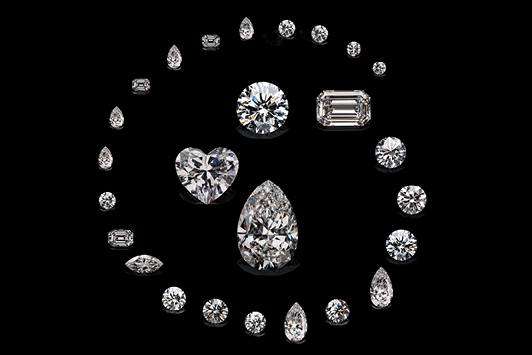
Big stones are a big prize for diamond miners. Enticed by a windfall payday, niche mining companies are investing millions to implement new technology that will raise their chances of unearthing these exceptional stones.
Finding the next Lesedi La Rona could cover the investment in one shot, as the 1,109-carat stone’s recent sale demonstrated. Lucara Diamond Corp. raised $130 million in just over a year from the combined sales of the Lesedi La Rona, the 813-carat Constellation, and a 373.72-carat diamond shard, all discovered at its Karowe mine in Botswana. That’s more than it cost to build the mine, a Lucara spokesperson told Rapaport Magazine following the Lesedi La Rona sale.
But very few resources have the ability to produce such diamonds. The likes of Karowe and Gem Diamonds’ Letšeng mine in Lesotho stand out for having a high concentration of these stones. So-called “specials” larger than 10.8 carats account for an estimated 70% to 80% of the revenue these mines generate.
“When you consider that, you’ll understand that the key part of what we do is to try and minimize damage to these stones, so that we recover as many as possible intact,” says Glenn Turner, chief legal and commercial officer at Gem Diamonds. That involves keeping chips from breaking off the diamond, but also maintaining the stone’s integrity, he explains.
That’s not so easy when you consider that mining is a violent process involving blasting rock and then processing ore through various stages of crushing and sorting. “Even though a diamond is the hardest substance on earth, it’s remarkable it can survive such a process,” Turner points out.
Recognizing the potential for such exceptional diamonds at Karowe, Lucara’s management took a “leap of faith” as an early adopter of x-ray transmission (XRT) technology at its processing plant, Lamb explains. XRT increases the chances of detecting these stones before they can get crushed.
The more traditional processing method of dense media separation (DMS) technology relies on the diamond’s nitrogen impurities to identify it. As such, large type IIa diamonds would often go unnoticed because they have a higher purity and therefore take longer to detect, Lamb says. XRT technology circumvents that by looking for the carbon content of the diamond rather than its impurities.
Lucara replaced its DMS systems with XRT machines at Karowe in 2015. Last month, it announced that additional XRT circuits had been commissioned at strategic locations in the processing plant. It also implemented what it called a Mega Diamond Recovery circuit, which is situated along the ore’s route to the processing plant and is designed to maximize the recovery of exceptional diamonds before damage can occur, the company explained. That completed the projects aimed at optimizing Lucara’s diamond recovery program — all at a cost of $103 million.
At Letšeng, Gem Diamonds has made engineering improvements to its secondary and tertiary crushers, but Turner acknowledges that’s not enough. He declines to comment on new capital investments planned for the processing plant, as the company is scheduled to update the market on its optimization program on October 31.
Gem Diamonds and Lucara are not the only companies engaged in improving their large-stone recoveries.
Petra Diamonds recently constructed a new plant at its Cullinan mine in South Africa, source of the famed 3,106-carat Cullinan diamond.
The new plant, which cost the company $11.7 million (ZAR 1.6 billion), incorporates “a gentler process than traditional crushing, which can break large diamonds,” explains Cathy Malins, Petra’s corporate communications manager.
Lucapa Diamond Company has different considerations at its Lulo mine in Angola, where its sales yielded an impressive $2,983 per carat in 2016. The chances of breakage are lower at Lulo, since it’s an alluvial operation, where the gravel is soft compared with the kimberlite ore that Petra, Gem and Lucara have to contend with.
While Lucapa CEO Stephen Wetherall notes the improvements the company made to its processing plant last year, its real opportunity lies in searching for the kimberlite source of the Lulo alluvial deposit. Lucapa’s focus to date has been to achieve sufficient cash flow that it could self-finance the alluvial operation without shareholder help, but Wetherall says the company will soon ramp up its exploration program.
Finding Lulo’s kimberlite source would be a significant boost for Lucapa, giving it access to a greater volume of production — and more importantly, exposing it to more of those exceptional rough diamonds, which would result in stronger long-term revenue growth.
After all, as Lamb notes, these diamonds are insurance against the market, where there continues to be volatility in smaller commercial goods. “Demand for large diamonds continues to increase, and we’re seeing more people participate in our big-stone tenders,” he observes.
Manufacturers achieve significantly better margins from these stones than from smaller diamonds, and there appears to be insatiable consumer demand among the super-rich for the beautiful jewels that emerge from the rough. It’s little wonder that the mining companies are expending resources to bring these diamonds to the market unscathed.
“It requires a considerable investment to avoid diamond damage, but it results in significantly more revenue,” Turner says. “We do everything in our power to address this, because it’s an enormous prize.”
Image: Graff Diamonds.Article from the Rapaport Magazine - October 2017. To subscribe click here.